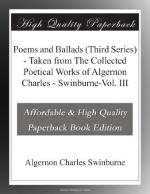|
This section contains 5,709 words (approx. 20 pages at 300 words per page) |

|
SOURCE: "Purity and Pain," in Vanishing Lives: Style and Self in Tennyson, D. G. Rossetti, Swinburne, and Yeats, University Press of Virginia, 1988, pp. 116-36.
In the following essay, Richardson provides a thematic and stylistic analysis of Swinburne's verse.

Less a personality than, as he might have put it, a shoreline, Swinburne is visible only as the hypnotically shifting border of land and sea, solidity and fluidity, cold strength and smothering passion. Because he lacks the patience and—though it may seem strange to say this of a man so eccentric and explosive—the self-indulgence of his mentor Rossetti, Swinburne can dwell only briefly in the Rossettian closeness
Though such swarming passions continuously inform his poetry, they are qualified, sometimes by enthusiastic wit, sometimes by poisonous guilt, and most often by that most remarkable aspect of Swinburne—his drive toward cold clarity, impossible innocence, superhuman strength, inhuman purity.
"The...
|
This section contains 5,709 words (approx. 20 pages at 300 words per page) |

|


